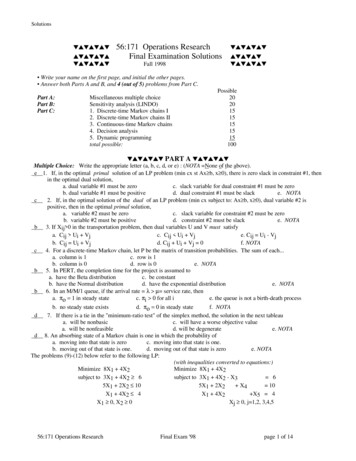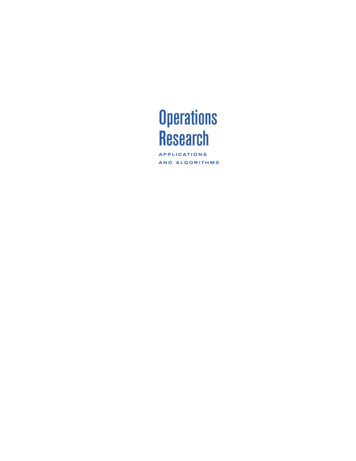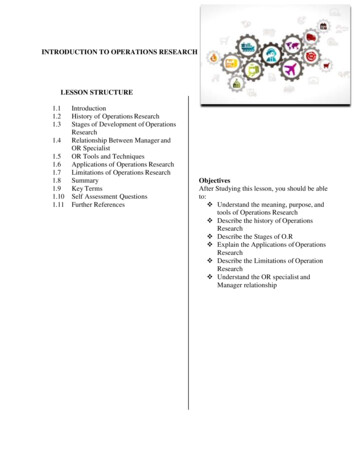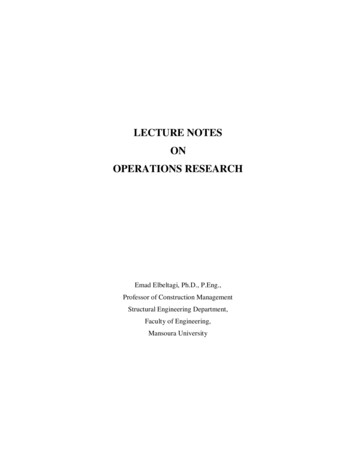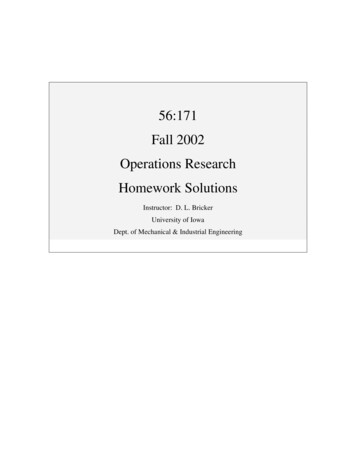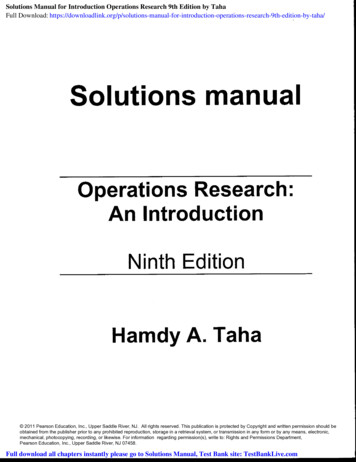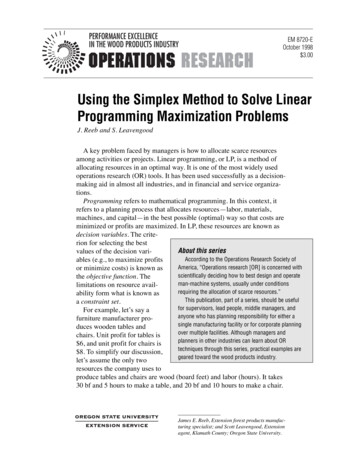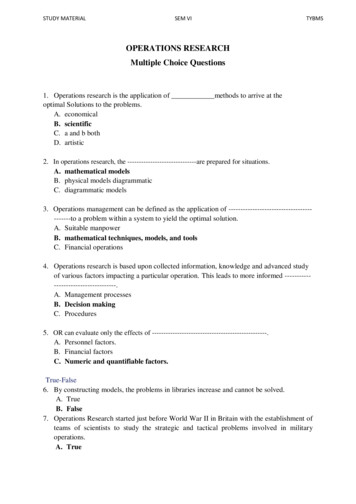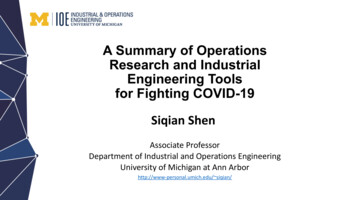
Transcription
A Summary of OperationsResearch and IndustrialEngineering Toolsfor Fighting COVID-19Siqian ShenAssociate ProfessorDepartment of Industrial and Operations EngineeringUniversity of Michigan at Ann Arborhttp://www-personal.umich.edu/ siqian/
OutlineqOverall LessonsqDisease PreventionqDisease Control During Outbreak Increasing Testing AbilityLockdown and QuarantineHealthcare System Reform and OperationsSupply Chains of Essential ItemsAirline Management and other Related ProblemsqRecovery and Post-Recovery PlanningqConclusion
Online Document and Summaryhttp://www-personal.umich.edu/ siqian/docs/or-ie-fighting-covid19 v1.pdf
Acknowledgement Current and former IOE PhD students who contributed references and sharedideas. PhD students who contributed to making the slides.
OutlineqOverall LessonsqDisease PreventionqDisease Control During Outbreak Increasing Testing AbilityLockdown and QuarantineHealthcare System Reform and OperationsSupply Chains of Essential ItemsAirline Management and other Related ProblemsqRecovery and Post-Recovery PlanningqConclusion
COVID-19 Stages in Different Countries(Source: McKinsey & Company)
What Data Science Can Show Us?
Exponential Growth and MichiganCOVID-19 Prediction
From Data to Actions, to Solutions What it takes to flatten the curve?” What problems that are involved inthe epidemic prevention,intervention, control and recoveryphases need to be solved? How Operations Research andIndustrial Engineering tools can help?
OutlineqOverall LessonsqDisease PreventionqDisease Control During Outbreak Increasing Testing AbilityLockdown and QuarantineHealthcare System Reform and OperationsSupply Chains of Essential ItemsAirline Management and other Related ProblemsqRecovery and Post-Recovery PlanningqConclusion
Testing Facility Location Design andTesting Kit Distribution Facility Location Problem (FLP) Decisions: Where to open facilities Constraints: Satisfy demand and do notexceed production/testing capacity Objective: Minimize cost (e.g., travelconvenience, cost for shipping test kits.)A map of Singapore indicating the number of Public Health Preparedness Clinics (PHPCs) in eacharea. Picture source:https://www.flugowhere.gov.sg/map?HCICode 19M0105&lat 1.36271542&lng 103.854645
To Build A Mathematical Model What we know (Input Data) Potential # of infected cases and population density, characteristics in each region. Traveling distance from manufactures/individuals to potential testing facilities. What we need to decide (Decision Variables) Whether or each location (e.g., CVS, Walmart parking lot) will be a potential testingfacility. Testing capacities in each location. Shipment volumes between manufactures and potential testing facilities. What are the goals (Objective) Minimize the total shipment cost from producers to the selected testing facilities. Maximize the traveling convenience from individuals to the selected testing facilities.Ref: Daskin, M. S. (2011). Network and Discrete Location: Models, Algorithms, and Applications.
What To Learn from SingaporeA helpful link to check the PHPC locations in e 19M0105&lat 1.36271542&lng 103.854645E.g., Ang Mo Kio is an area with many apartments, so there are lots of PHPCsaround it.
Locating Key Hospitals and Preparing Enough PPEs Facility location with multistage demand uncertainty: We need to consider dynamic demand over time.Picture source: virusus-cases.html?campaignId 7JFJXRef: Zaric, G. S., & Brandeau, M. L. (2002). Dynamic resource allocation for epidemic control inmultiple populations. Mathematical Medicine and Biology, 19(4), 235-255.
OutlineqOverall LessonsqDisease PreventionqDisease Control During Outbreak Increasing Testing AbilityLockdown and QuarantineHealthcare System Reform and OperationsSupply Chains of Essential ItemsAirline Management and other Related ProblemsqRecovery and Post-Recovery PlanningqConclusion
Increasing Testing AbilitySingaporeSouth KoreaHealth workers in protective suits talk to a motorist at a drive-through testing centerfor COVID-19 in Seoul. Credit: Ed Jones/AFP via Getty ImagesSingapore has been able to contain the virus, in part by conducting screenings at theairport. Credit: Adam Dean for The New York es.html
Increasing Testing Early Detection and Treatment “countries that have tested widely for the virus, isolated cases and quarantinedsuspected cases — in the way that South Korea and Singapore have done — havemanaged to suppress transmission of the virus” “the key lessons from her country are that it developed testing for the virus evenbefore it had a significant number of cases” "Testing is central to the outbreak response”, said Kang, "because that leads toearly detection. It minimizes further spread." And it allows health authorities toquickly isolate and treat those found with the outbreak-without-shutting-everything-down
When and How to LockdownDepending on differentseverity levels of virus spread,medical supply shortage, andprediction of future situation,policy makers need todynamically decide what typesof events, stores, restaurants,and other public facilities toclose, whether we closeschools, parks, etc.
Prevention vs. InterventionEerie scenes of an empty New York City as coronavirus lockdown loomsCredit: Daniel William McKnight for The New York ms/
To Build A Lockdown Model What we know (Input Data) The frequency that each location/facility is visited and how important theyare to people’s daily life What we need to decide (Decision Variables) Whether or not to close each facility (if yes, then at what time) What are the goals (Objective) Minimize the total infections while supporting people’s daily-life needsMinimize the inconvenience caused by facility locked-downMinimize economic impact
Lockdown – A Knapsack Problem Select facilities to close and populations to quarantine/get vaccination Such a static model can be extended to a dynamic setting if we update the virusspread information periodically and make updated lockdown decisions sequentially.Ref: Deng, Y., Shen, S., & Vorobeychik, Y. (2013). Optimization methods for decision making indisease prevention and epidemic control. Mathematical Biosciences, 246(1), 213-227.
To Build A Quarantine Model What we know (Input Data)A network with nodes representing population groups or facilities and edgesrepresenting how they are connected. What we need to decide (Decisions) Identify the most critical nodes (e.g., facilities visited by most people daily orworkers such as doctors who may infect a large number of vulnerablepopulations if they are sick) What are the goals (Objective) Provide extra protection for the most critical nodes during their normaloperations or quarantine them if they are infected
An Interdiction Model for Disconnecting a Network Decide which node(s) to delete (quarantine) to maximize network disconnectivity.Ref: Shen, S., Smith, J. C., & Goli, R. (2012). Exact interdiction models and algorithms fordisconnecting networks via node deletions. Discrete Optimization, 9(3), 172-188.
To Build A Treatment Model What we know (Input Data) A network with nodes and edges to model social connections and interactions The number of agents that move and clean a spreading contamination Contamination/cleaning speed What we need to decide (Decisions) Select nodes to “clean” (treat) when the virus moves around to infect nonquarantined nodes. What are the goals (Objective) Minimize the time to decontaminate the graph Minimize the number of cleaning agents needed
Integer Programming for Configuring Treatment Plans Finding the fastest cleaning strategy while the virus is spreading:Ref: Penuel, J., Cole Smith, J., & Shen, S. (2013). Integer programming models and algorithmsfor the graph decontamination problem with mobile agents. Networks, 61(1), 1-19.
OutlineqOverall LessonsqDisease PreventionqDisease Control During Outbreak Increasing Testing AbilityLockdown and QuarantineHealthcare System Reform and OperationsSupply Chains of Essential ItemsAirline Management and other Related ProblemsqRecovery and Post-Recovery PlanningqConclusion
Improving Healthcare OperationsIssue: High demand under tight resourcesGoal: Avoid overcrowdedness and cross-infectionICU bed allocationPatient admission ControlStaff planningAmbulance virus-front-lines-11583344415
Is US Fine with ICU Beds?What is NOT reflected in the figure: Imbalanced healthcare resources indifferent states, counties in the US. Extremely high population density incertain regions, e.g., NYC. Normal ICU bed demand andutilization. Extremely high healthcare cost andICU cost in the US.
Patient Triage and Admission ControlWhat we need to decide: Prioritize which patients need to be tested & admitted How to triage patient flows in emergency departments Assign appropriate shifts to doctors and nursesDepartment of Health published algorithm for triage ofpatients with possible COVID-19 infection.What we consider: Patient safety Operational efficiency The risk that healthcare providers are exposed to infectious patientsCDC updated the priority list for evaluation andlaboratory testing for /hcp/clinical-criteria.html 53888995328
Patient Triage and Admission ControlPrioritize which patients need to be tested & admitted An expedited patient care queue (a Markov decision process model) To strike a balance between bed utilization and hospital congestionScheduled patients andemergency patients areassigned hospital bedsaccording to a Poisson process .The controller has the option of canceling anarriving scheduled patientCall-in patients are placed on the call-in queue according to a Poissonprocess and are then assigned a hospital bed (admitted) via theadmission controller’s call-in action.Ref: Helm, J. E., AhmadBeygi, S., & Van Oyen, M. P. (2011). Design and analysis of hospital admissioncontrol for operational effectiveness. Production and Operations Management, 20(3), 359-374.
Patient Triage and Admission ControlTriage patient flows in emergency departmentsTwo challenges:1. Deciding what information to collect at triage2. Determining how to use the information toimprove performance. Separate patients into streams and prioritizethem within the streams.Ref: Saghafian, S., Hopp, W. J., Van Oyen, M. P., Desmond, J. S., & Kronick, S. L. (2014). Complexityaugmented triage: A tool for improving patient safety and operational efficiency. Manufacturing &Service Operations Management, 16(3), 329-345.
Hospital Capacity AllocationThe ICU is at capacity, patient beds line thehallways of the emergency department, and themorgue is overflowing.Plastic sheets separate an area of the hospitalbeing used to treat coronavirus n-hospital-coronavirus-patients-deaths/index.html
Importance of ICU Beds AllocationHaving enough ICUs and ventilators is critical fortreating COVID-19 patients as about 20% patientsreported so far have critical conditions.ChinaAs an example, as of March 23, 2020, Germany has 132 deaths amongall the 31,370 confirmed cases, close to 0.4% fatality rate, ascompared to the nearly 10% fatality rate in phic/#36994f817f8
Ways to Expand CapacitiesCreate plans to increase capacityConverting single rooms to doublesDischarging patientsDefining how to allocate scarce technologies(involving clinical staff and ethicists)Reducing admissions fornon-COVID-19 careProviding training tohealthcare s rus-more-effectively-could-we-still/ latorsother-covid-19-resources-based-on-evidence/ r-coronavirus-crisis
To Build A Mathematical ModelCondition: Patients are divided into different types. The wards for each patient type are separated.What we know (Input Data): Patients transition from one type to another. Each medical staff has their specialties and working-shift preferences.What we need to decide (Decision Variables): How to allocate capacity (i.e., number of beds and medical staff) in each ward.Allocation of ICU beds (Modeled as a MarkovDecision Processes (MDP))1. Whether the patient should be admitted to theICU or the general ward?2. Which patients in the ICU (if any) should beearly discharged to the general ward?Goal: minimize death trollRef:
From Data to Actions, to Solutions What it takes to flatten the curve?” What problems that are involved in the epidemic prevention, intervention, control and recovery phases need to be solved? How Operations Research and Industrial Engineering tools can help? Outline qOverall Lessons qDisease Prevention qDisease Control During Outbreak Increasing Testing Ability .


